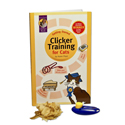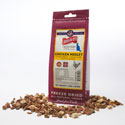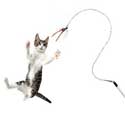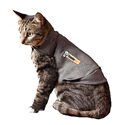My wife and I have a eight-year-old cat named Phoebus, whom she rescued as a kitten. When she found him, he was one week away from being put to sleep by the local shelter; his mother had leukemia, and of his entire litter, only he had survived. He's a great cat, with a firm but sweet disposition, and, until recently, he had never been clicker trained. He did all the normal things you want a cat to do—use a litter box, hunt mice, play, purr—but he also did some of the normal things you don't want a cat to do.

Phoebus giving our former webmaster
a "high five" on cue.
One behavior I was particularly anxious to curb was Phoebus's jumping and scratching while we were having dinner. I guess this was my own fault, really. Often at dinner I'd given Phoebus a bit or two of fish or chicken, just to see him light up at the treats. There was no rhyme or reason to it; I just gave him some of our dinner when I thought it was something he'd particularly enjoy. However, this sporadic treating gave rise to an unceasing desire for people food. Every night, he'd start crying the minute I'd sit down to eat. No matter what was on the menu, he wanted to be offered some, whether he'd eat it or not. When I wouldn't give him any, he'd start scratching me, scratching the table, climbing on the table, whatever would get our attention. Pushing him away or yelling "no!" didn't make a bit of difference; he'd come right back as soon as I started eating again.
This all ended once I joined the team at Karen Pryor Clickertraining and started clicking with my cat. Here's what I did:
First, I tried to click and treat him for a calm "sit" at dinner time, thinking that training an incompatible behavior might stop all the scratching and crying. That worked to a degree, but it was a brittle solution. He'd sit for a few seconds, watch me have a bite or two, get frustrated, and start looking for attention again. I tried clicking for duration by waiting longer and longer between sit and treat, but again, there was only so long he could sit before the temptation of the plates overwhelmed him. I kept this up for a couple of weeks, until I came upon a better solution.
Again, since I love our cat and he does everything I want a cat to do, I didn't see any reason to start training him, but this situation presented me with an opportunity to put my understanding of clicker training to the test. I picked up the Clicker Fun Cards for Cats at my wife's request, and started by teaching Phoebus how to "Kitty High Five." It's very easy to train, and it really impresses guests. Once he could reliably high five, I started asking him for it at dinner time. Since his mind was already on getting my attention in order to get some treats, he picked up on the association very quickly: I wouldn't give him a treat unless he performed his one trick. Sure, to get the second or third treat he'd go right back to crying, but after a few nights he learned that high five was the only way to his beloved fresh meat.
I had a hard time not correcting him during this process; I had to keep ignoring the crying and the clawing and the climbing, fighting the urge to put him outside, just waiting for him to sit back down. Luckily, it didn't take long for him to catch on to what I was doing either, and to start looking for practical alternatives.
Next I combined the sit with the high five. First, I wouldn't pay any attention to him unless he was sitting. Then, I'd stick out my hand and say "high five!" he'd give me five, and get a treat. This worked perfectly. He knows that he doesn't get a treat unless he gives me a high five, and I won't ask for a high five until he's sitting quietly. Now I have a cat who sits quietly, looking up at me, waiting for opportunities to get clicks.
Since eliminating the unwanted behavior, I've turned the whole thing into a game. I break up tiny bits of food, just enough to be findable, and every time he gives me a high five, I throw a bit of food somewhere around the room. He bolts in the direction of the treat, pounces on it, and after eating it, sits and considers his kill while licking himself contentedly. After a minute, he comes back to me, sits, and waits for his next prey. Thanks Karen! You've helped me teach an old cat new tricks.







Post new comment